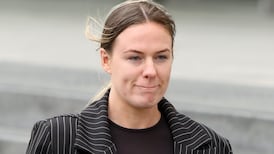About 96km (60 miles) north of Seattle in Washington state lies Whidbey Island, a tranquil and beautiful place much prized by day-trippers seeking to escape the city for a few hours. On the island, the town of Coupeville boasts a historic waterfront whose Victorian-style buildings contain cafes and antique shops, while its hinterland is a 7,000-hectare (17,400-acre) national park.
Remember the glacial lakes, misty mountains and creepy pine forests from the Twilight movies? That's the sort of landscape we're talking about.
If it’s an Irish connection you’re after, however, you’ll need to head for Coupeville’s Sunnyside Cemetery, where you’ll find a gravestone with an Irish-language inscription, written in cló Gaelach, an old Gaelic script dating from the 16th century.
“Fúr Máire Barrot bás ann so Ap 9 AD 1861,” the inscription begins, “do bhí aon bhlighian dheug air fhícid daos aici . . .”
To find a gravestone inscribed in Irish in this place is astonishing enough: that it should be written in cló Gaelach is extraordinary. We are indebted to John Keane, who drew our attention to the story and sent us a wealth of background information.
In 1847, the worst year of the Famine, a man called Samuel Maylor left his native Cork with his brother Thomas. After a meandering journey west, the brothers settled on a peninsula on Whidbey Island which, to this day, is known as Maylor’s Point.
Samuel returned to Ireland in 1855 and married Mary, or Máire, Barrett from Nenagh, Co Tipperary. When Mary died in 1861, aged just 31, the heartbroken Samuel once again headed to Ireland with their three children, had the headstone sculpted and inscribed, and brought it back to Mary’s grave at Maylor’s Point.
Hazardous journey
Maylor’s devotion to his wife’s memory is as impressive as his talent for travel. The journey to fetch the headstone, via Cape Horn, took five to six months each way. His original voyage to the US took him first to Boston then by schooner to New York, around the western tip of Cuba, across the Isthmus of Panama on foot – a long and hazardous journey in itself – and northwards along the coast to the wild, untamed area that would become the city of Seattle.
“In the early 1800s,” says Keane, “there were numerous trappers, miners, prospectors, etc, in this area, but no settlers. There were plenty of Native Americans but they didn’t build settlements – instead, fishing and hunting was their main pursuit. The Pacific Northwest was definitely a wild country then.”
On Whidbey, Samuel made his living as a gunsmith. Locals and visitors, white and Native American alike, came to him to have their weapons repaired – some from as far away as Canada. But pioneer life was tough. Mary died when the youngest of the Maylors’ three sons, also called Samuel, was born. After his epic voyage to commemorate his wife Samuel married her cousin, Margaret, and they had a further five children together.
Sorrow wasn’t done with him. Following Margaret’s death in 1891, Samuel Maylor jnr travelled to Nanaimo in British Columbia, Canada, to check out a property purchased by his father. He never returned. His disappearance, Maylor’s granddaughter Juanita Maylor Bonnelle would report in 1947, “caused his father great sorrow”. Samuel Maylor himself died in 1896.
During the second World War, Maylor’s Point was taken over by the US air force and in 1973, the Maylor headstone was placed in Sunnyside Cemetery.
Keane, who was born in Rosemount, Co Westmeath, left Ireland exactly 50 years ago, in the summer of 1967. He has lived in the Seattle area since 1978 and was appointed honorary Irish consul in Seattle in 2009. “After finding out about the stone about eight years ago, I’ve tried to publicise an interest in it and in many of the other Irish connections in the Seattle area,” he says.
Despite its graveyard location, this Irish connection has an upbeat ending. In 2013, Keane brought a group of Irish musicians to visit the headstone "to play a few tunes and remember the Maylors". You can see the 2013 ceremony online, and watch him in action, at https://youtu.be/L5NFPHIfO-w. For further details of the story check out the Seattle Irish Heritage Club's website, www.irishclub.org
* If you know of an Irish connection which would interest readers of this column, please email awallace@irishtimes.com with details of the story, as well as your contact address.















